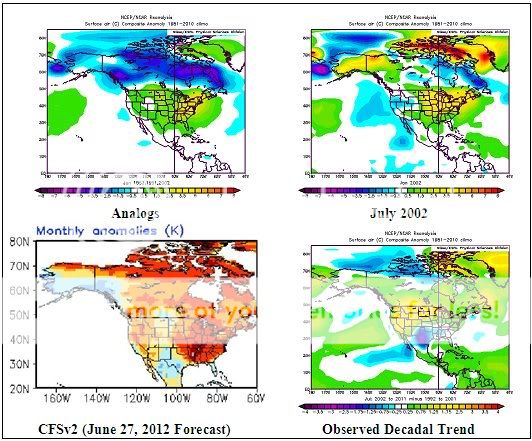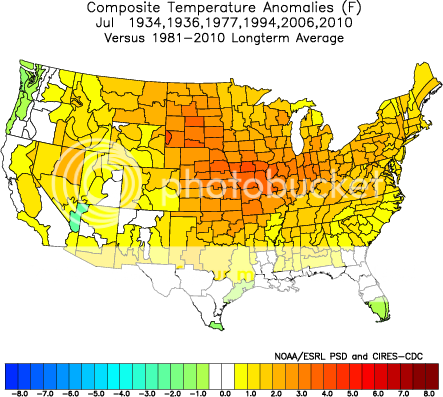(Blog Written by Donald Sutherland)
July 2012 Forecast:
Despite the likely emergence of an El Niño event in July, the month will likely be uncharacteristically warm. In fact, when one considers the likely ENSO Region 1+2 anomaly of +1.0°C or above, the warmth that appears likely will be exceptional.
Key Assumptions:
• An El Niño event will develop in July
• The AO will likely be near neutral (with variability in negative and positive ranges)
• The PNA will likely be near neutral.
The top analog was 2002.
The charts on which my July idea is based are:
Top Left: Analogs for July 2012
Top Right: July 2002
Bottom Left: CFSv2 Forecast for July
Bottom Right: Observed decadal temperature trend

In addition, if one considers the exceptionally warm spring (March-May 2012 ranked 1st in the CONUS) and warm June nationwide (a top 30 or warmer June appears likely) with ENSO Region 3.4 temperatures in the +27.25°C to +28.25°C range for June, one comes up with the following cases: 1934, 1936, 1977, 1994, 2006, and 2010. That situation has favored widespread heat in July, particularly in the Central Plains.

Factoring in the continued abnormal warmth in the Arctic, the analog situation of a large area of cool anomalies across Canada appears very unlikely. As a result, the magnitude of warmth could be even greater than what the analog cases suggest.
Based on the prevalent conditions in the Arctic region, observed decadal trend, warm spring/warm June cases, analogs, and CFSv2, my thoughts are as follows:
– Most of North America will likely be warmer than normal.
– An area the Southern/Central Plains and then eastward through the Great Lakes into the Southeast/Mid-Atlantic/parts of the Northeastern U.S. could be much warmer than normal
– Most of Canada will likely be warmer than normal. The most impressive warmth could be located in northernmost Canada and also southern Ontario (including the Toronto Metro Area)
– Cool anomalies are likely to be confined to the immediate U.S. West Coast and the Pacific coast of Canada
